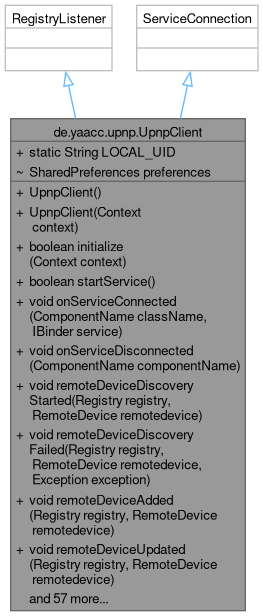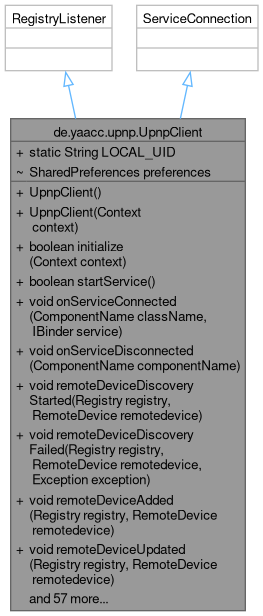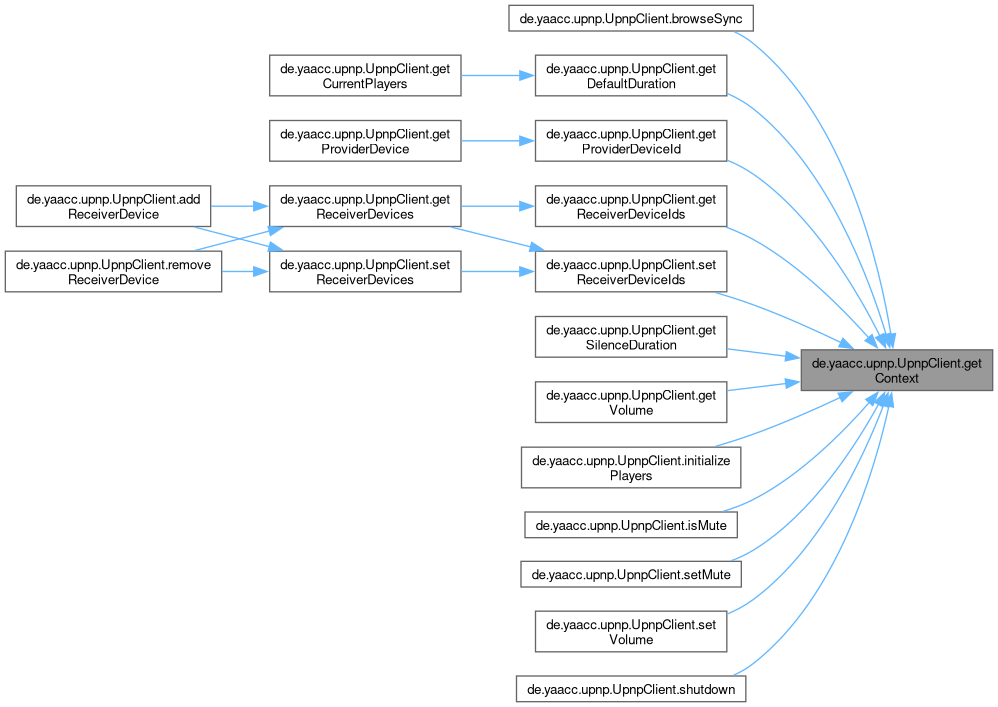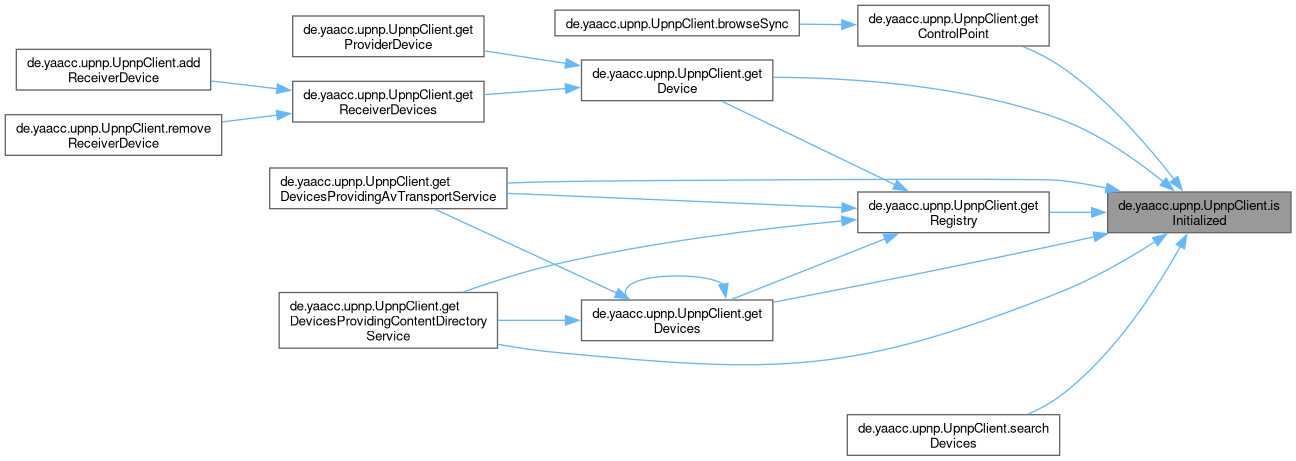A client facade to the upnp lookup and access framework. More...


Classes | |
| class | LocalDummyDevice |
Public Member Functions | |
| UpnpClient (Context context) | |
| boolean | initialize (Context context) |
| Initialize the Object. | |
| boolean | startService () |
| void | onServiceConnected (ComponentName className, IBinder service) |
| void | onServiceDisconnected (ComponentName componentName) |
| void | remoteDeviceDiscoveryStarted (Registry registry, RemoteDevice remotedevice) |
| void | remoteDeviceDiscoveryFailed (Registry registry, RemoteDevice remotedevice, Exception exception) |
| void | remoteDeviceAdded (Registry registry, RemoteDevice remotedevice) |
| void | remoteDeviceUpdated (Registry registry, RemoteDevice remotedevice) |
| void | remoteDeviceRemoved (Registry registry, RemoteDevice remotedevice) |
| void | localDeviceAdded (Registry registry, LocalDevice localdevice) |
| void | localDeviceRemoved (Registry registry, LocalDevice localdevice) |
| void | beforeShutdown (Registry registry) |
| void | afterShutdown () |
| Service<?, ?> | getAVTransportService (Device<?, ?, ?> device) |
| Returns a Service of type AVTransport. | |
| Service<?, ?> | getRenderingControlService (Device<?, ?, ?> device) |
| Returns a Service of type RenderingControl. | |
| void | addUpnpClientListener (UpnpClientListener listener) |
| Add an listener. | |
| Collection< Device<?, ?, ?> > | getDevices () |
| Returns all registered UpnpDevices. | |
| Collection< Device<?, ?, ?> > | getDevicesProvidingContentDirectoryService () |
| Returns all registered UpnpDevices with a ContentDirectory Service. | |
| Collection< Device<?, ?, ?> > | getDevicesProvidingAvTransportService () |
| Returns all registered UpnpDevices with an AVTransport Service. | |
| Device<?, ?, ?> | getDevice (String identifier) |
| Returns a registered UpnpDevice. | |
| boolean | isInitialized () |
| True if the client is initialized. | |
| ControlPoint | getControlPoint () |
| returns the upnp control point | |
| Registry | getRegistry () |
| Returns the upnp registry. | |
| Context | getContext () |
| ContentDirectoryBrowseResult | browseSync (Position pos) |
| Browse ContenDirctory synchronous. | |
| ContentDirectoryBrowseResult | browseSync (Position pos, Long firstResult, Long maxResult) |
| ContentDirectoryBrowseResult | browseSync (Device<?, ?, ?> device, String objectID, BrowseFlag flag, String filter, long firstResult, Long maxResults, SortCriterion... orderBy) |
| Browse ContenDirctory synchronous. | |
| void | searchDevices () |
| Search asynchronously for all devices. | |
| List< Player > | initializePlayers (DIDLObject didlObject) |
| Returns all player instances initialized with the given didl object. | |
| List< Player > | initializePlayers (List< Item > items) |
| Returns all player instances initialized with the given didl object. | |
| List< Player > | initializePlayers (AvTransport transport) |
| Returns all player instances initialized with the given transport object. | |
| Collection< Player > | getCurrentPlayers () |
| Returns all current player instances. | |
| List< Player > | getCurrentPlayers (AvTransport transport) |
| Returns all current player instances for the given transport object. | |
| List< Item > | toItemList (DIDLContent didlContent) |
| returns a list of all items including items in containers for the given didlContent | |
| List< Item > | toItemList (DIDLObject didlObject) |
| Converts the content of a didlObject into a list of cling items. | |
| Set< String > | getReceiverDeviceIds () |
| Gets the receiver IDs, if none is defined the local device will be returned. | |
| void | setReceiverDeviceIds (Set< String > receiverDeviceIds) |
| Set the list of receiver device ids. | |
| Collection< Device<?, ?, ?> > | getReceiverDevices () |
| Returns the receiverIds stored in the preferences. | |
| int | getReceiverDevicesReadyCount () |
| void | setReceiverDevices (Collection< Device<?, ?, ?> > receiverDevices) |
| set the receiverDevices to the devices in the given collection. | |
| void | addReceiverDevice (Device<?, ?, ?> receiverDevice) |
| add a receiver device | |
| void | removeReceiverDevice (Device<?, ?, ?> receiverDevice) |
| remove a receiver device | |
| String | getProviderDeviceId () |
| Device<?, ?, ?> | getProviderDevice () |
| void | setProviderDevice (Device<?, ?, ?> provider) |
| void | shutdown () |
| Shutdown the upnp client and all players. | |
| int | getDefaultDuration () |
| Return the configured default duration. | |
| int | getSilenceDuration () |
| Return the configured silence duration. | |
| boolean | isMute () |
| returns the mute state | |
| void | setMute (boolean mute) |
| set the mute state | |
| int | getVolume () |
| returns the current volume level | |
| void | setVolume (int desired) |
| set the volume in the range of 0-100 | |
| void | downloadItem (DIDLObject selectedDIDLObject) |
| List< Player > | initializePlayersWithPlayableItems (List< PlayableItem > items) |
| boolean | getMute (Device<?, ?, ?> device) |
| boolean | hasActionGetMute (Device<?, ?, ?> device) |
| void | setMute (Device<?, ?, ?> device, boolean mute) |
| int | getVolume (Device<?, ?, ?> device) |
| boolean | hasActionGetVolume (Device<?, ?, ?> device) |
| void | setVolume (Device<?, ?, ?> device, int volume) |
| boolean | hasActionSetVolume (Service<?, ?> service) |
| Optional< Player > | getPlayer (int id) |
| void | addToPlaylist (DIDLObject item) |
| PlayableItem | createPlayableItem (Uri uri) throws IOException |
| boolean | isPlayerServiceInitialized () |
Static Public Attributes | |
| static String | LOCAL_UID = "LOCAL_UID" |
Detailed Description
A client facade to the upnp lookup and access framework.
This class provides all services to manage devices.
Member Function Documentation
◆ addReceiverDevice()
| void de.yaacc.upnp.UpnpClient.addReceiverDevice | ( | Device<?, ?, ?> | receiverDevice | ) |
add a receiver device
- Parameters
-
receiverDevice receiverDevice

◆ addUpnpClientListener()
| void de.yaacc.upnp.UpnpClient.addUpnpClientListener | ( | UpnpClientListener | listener | ) |
Add an listener.
- Parameters
-
listener the listener to be added
◆ browseSync() [1/2]
| ContentDirectoryBrowseResult de.yaacc.upnp.UpnpClient.browseSync | ( | Device<?, ?, ?> | device, |
| String | objectID, | ||
| BrowseFlag | flag, | ||
| String | filter, | ||
| long | firstResult, | ||
| Long | maxResults, | ||
| SortCriterion... | orderBy | ||
| ) |
Browse ContenDirctory synchronous.
- Parameters
-
device the device to be browsed objectID the browsing root flag kind of browsing
- See also
BrowseFlag
- Parameters
-
filter a filter firstResult first result maxResults max result count orderBy sorting criteria
- See also
SortCriterion
- Returns
- the browsing result

◆ browseSync() [2/2]
| ContentDirectoryBrowseResult de.yaacc.upnp.UpnpClient.browseSync | ( | Position | pos | ) |
Browse ContenDirctory synchronous.
- Parameters
-
pos Position the device and object to be browsed
- Returns
- the browsing result
◆ getAVTransportService()
| Service<?, ?> de.yaacc.upnp.UpnpClient.getAVTransportService | ( | Device<?, ?, ?> | device | ) |
Returns a Service of type AVTransport.
- Parameters
-
device the device which provides the service
- Returns
- the service of null
◆ getContext()
| Context de.yaacc.upnp.UpnpClient.getContext | ( | ) |
- Returns
- the context
Referenced by de.yaacc.upnp.UpnpClient.browseSync(), de.yaacc.upnp.UpnpClient.getDefaultDuration(), de.yaacc.upnp.UpnpClient.getProviderDeviceId(), de.yaacc.upnp.UpnpClient.getReceiverDeviceIds(), de.yaacc.upnp.UpnpClient.getSilenceDuration(), de.yaacc.upnp.UpnpClient.getVolume(), de.yaacc.upnp.UpnpClient.isMute(), de.yaacc.upnp.UpnpClient.setMute(), de.yaacc.upnp.UpnpClient.setReceiverDeviceIds(), de.yaacc.upnp.UpnpClient.setVolume(), and de.yaacc.upnp.UpnpClient.shutdown().

◆ getControlPoint()
| ControlPoint de.yaacc.upnp.UpnpClient.getControlPoint | ( | ) |
returns the upnp control point
- Returns
- the control point
Referenced by de.yaacc.upnp.UpnpClient.browseSync().


◆ getCurrentPlayers() [1/2]
| Collection< Player > de.yaacc.upnp.UpnpClient.getCurrentPlayers | ( | ) |
Returns all current player instances.
- Returns
- the player
◆ getCurrentPlayers() [2/2]
| List< Player > de.yaacc.upnp.UpnpClient.getCurrentPlayers | ( | AvTransport | transport | ) |
Returns all current player instances for the given transport object.
- Parameters
-
transport the object which describes the content to be played
- Returns
- the player

◆ getDefaultDuration()
| int de.yaacc.upnp.UpnpClient.getDefaultDuration | ( | ) |
Return the configured default duration.
- Returns
- the duration
Referenced by de.yaacc.upnp.UpnpClient.getCurrentPlayers().


◆ getDevice()
| Device<?, ?, ?> de.yaacc.upnp.UpnpClient.getDevice | ( | String | identifier | ) |
Returns a registered UpnpDevice.
- Returns
- the upnpDevice null if not found
Referenced by de.yaacc.upnp.UpnpClient.getProviderDevice(), and de.yaacc.upnp.UpnpClient.getReceiverDevices().


◆ getDevices()
| Collection< Device<?, ?, ?> > de.yaacc.upnp.UpnpClient.getDevices | ( | ) |
Returns all registered UpnpDevices.
- Returns
- the upnpDevices
Referenced by de.yaacc.upnp.UpnpClient.getDevices(), de.yaacc.upnp.UpnpClient.getDevicesProvidingAvTransportService(), and de.yaacc.upnp.UpnpClient.getDevicesProvidingContentDirectoryService().


◆ getDevicesProvidingAvTransportService()
| Collection< Device<?, ?, ?> > de.yaacc.upnp.UpnpClient.getDevicesProvidingAvTransportService | ( | ) |
Returns all registered UpnpDevices with an AVTransport Service.
- Returns
- the upnpDevices

◆ getDevicesProvidingContentDirectoryService()
| Collection< Device<?, ?, ?> > de.yaacc.upnp.UpnpClient.getDevicesProvidingContentDirectoryService | ( | ) |
Returns all registered UpnpDevices with a ContentDirectory Service.
- Returns
- the upnpDevices

◆ getProviderDevice()
| Device<?, ?, ?> de.yaacc.upnp.UpnpClient.getProviderDevice | ( | ) |
- Returns
- the provider device

◆ getProviderDeviceId()
| String de.yaacc.upnp.UpnpClient.getProviderDeviceId | ( | ) |
- Returns
- the providerDeviceId
Referenced by de.yaacc.upnp.UpnpClient.getProviderDevice().


◆ getReceiverDeviceIds()
| Set< String > de.yaacc.upnp.UpnpClient.getReceiverDeviceIds | ( | ) |
Gets the receiver IDs, if none is defined the local device will be returned.
- Returns
- the receiverDeviceIds
Referenced by de.yaacc.upnp.UpnpClient.getReceiverDevices().


◆ getReceiverDevices()
| Collection< Device<?, ?, ?> > de.yaacc.upnp.UpnpClient.getReceiverDevices | ( | ) |
Returns the receiverIds stored in the preferences.
If an receiver id is unknown it will be removed.
- Returns
- the receiverDevices
Referenced by de.yaacc.upnp.UpnpClient.addReceiverDevice(), and de.yaacc.upnp.UpnpClient.removeReceiverDevice().


◆ getRegistry()
| Registry de.yaacc.upnp.UpnpClient.getRegistry | ( | ) |
Returns the upnp registry.
- Returns
- the registry
Referenced by de.yaacc.upnp.UpnpClient.getDevice(), de.yaacc.upnp.UpnpClient.getDevices(), de.yaacc.upnp.UpnpClient.getDevicesProvidingAvTransportService(), and de.yaacc.upnp.UpnpClient.getDevicesProvidingContentDirectoryService().


◆ getRenderingControlService()
| Service<?, ?> de.yaacc.upnp.UpnpClient.getRenderingControlService | ( | Device<?, ?, ?> | device | ) |
Returns a Service of type RenderingControl.
- Parameters
-
device the device which provides the service
- Returns
- the service of null
◆ getSilenceDuration()
| int de.yaacc.upnp.UpnpClient.getSilenceDuration | ( | ) |
Return the configured silence duration.
- Returns
- the duration

◆ getVolume()
| int de.yaacc.upnp.UpnpClient.getVolume | ( | ) |
returns the current volume level
- Returns
- the value in the range of 0-100

◆ initialize()
| boolean de.yaacc.upnp.UpnpClient.initialize | ( | Context | context | ) |
Initialize the Object.
- Parameters
-
context the context
- Returns
- true if initialization completes correctly
◆ initializePlayers() [1/3]
| List< Player > de.yaacc.upnp.UpnpClient.initializePlayers | ( | AvTransport | transport | ) |
Returns all player instances initialized with the given transport object.
- Parameters
-
transport the object which describes the content to be played
- Returns
- the player
◆ initializePlayers() [2/3]
| List< Player > de.yaacc.upnp.UpnpClient.initializePlayers | ( | DIDLObject | didlObject | ) |
Returns all player instances initialized with the given didl object.
- Parameters
-
didlObject the object which describes the content to be played
- Returns
- the player
Referenced by de.yaacc.upnp.UpnpClient.initializePlayers().


◆ initializePlayers() [3/3]
| List< Player > de.yaacc.upnp.UpnpClient.initializePlayers | ( | List< Item > | items | ) |
Returns all player instances initialized with the given didl object.
- Parameters
-
items the items to be played
- Returns
- the player
◆ isInitialized()
| boolean de.yaacc.upnp.UpnpClient.isInitialized | ( | ) |
True if the client is initialized.
- Returns
- true or false
Referenced by de.yaacc.upnp.UpnpClient.getControlPoint(), de.yaacc.upnp.UpnpClient.getDevice(), de.yaacc.upnp.UpnpClient.getDevices(), de.yaacc.upnp.UpnpClient.getDevicesProvidingAvTransportService(), de.yaacc.upnp.UpnpClient.getDevicesProvidingContentDirectoryService(), de.yaacc.upnp.UpnpClient.getRegistry(), and de.yaacc.upnp.UpnpClient.searchDevices().

◆ isMute()
| boolean de.yaacc.upnp.UpnpClient.isMute | ( | ) |
returns the mute state
- Returns
- the state

◆ removeReceiverDevice()
| void de.yaacc.upnp.UpnpClient.removeReceiverDevice | ( | Device<?, ?, ?> | receiverDevice | ) |
remove a receiver device
- Parameters
-
receiverDevice receiverDevice

◆ setMute()
| void de.yaacc.upnp.UpnpClient.setMute | ( | boolean | mute | ) |
set the mute state
- Parameters
-
mute the state

◆ setReceiverDeviceIds()
| void de.yaacc.upnp.UpnpClient.setReceiverDeviceIds | ( | Set< String > | receiverDeviceIds | ) |
Set the list of receiver device ids.
- Parameters
-
receiverDeviceIds the device ids.
Referenced by de.yaacc.upnp.UpnpClient.getReceiverDevices(), and de.yaacc.upnp.UpnpClient.setReceiverDevices().


◆ setReceiverDevices()
| void de.yaacc.upnp.UpnpClient.setReceiverDevices | ( | Collection< Device<?, ?, ?> > | receiverDevices | ) |
set the receiverDevices to the devices in the given collection.
- Parameters
-
receiverDevices the devices
Referenced by de.yaacc.upnp.UpnpClient.addReceiverDevice(), and de.yaacc.upnp.UpnpClient.removeReceiverDevice().


◆ setVolume()
| void de.yaacc.upnp.UpnpClient.setVolume | ( | int | desired | ) |
set the volume in the range of 0-100
- Parameters
-
desired volume

◆ toItemList() [1/2]
| List< Item > de.yaacc.upnp.UpnpClient.toItemList | ( | DIDLContent | didlContent | ) |
returns a list of all items including items in containers for the given didlContent
- Parameters
-
didlContent the content
- Returns
- all items included in the content
Referenced by de.yaacc.upnp.UpnpClient.initializePlayers(), de.yaacc.upnp.UpnpClient.toItemList(), and de.yaacc.upnp.UpnpClient.toItemList().


◆ toItemList() [2/2]
| List< Item > de.yaacc.upnp.UpnpClient.toItemList | ( | DIDLObject | didlObject | ) |
Converts the content of a didlObject into a list of cling items.
- Parameters
-
didlObject the content
- Returns
- the list of cling items

The documentation for this class was generated from the following file:
- /github/workspace/yaacc/src/main/java/de/yaacc/upnp/UpnpClient.java